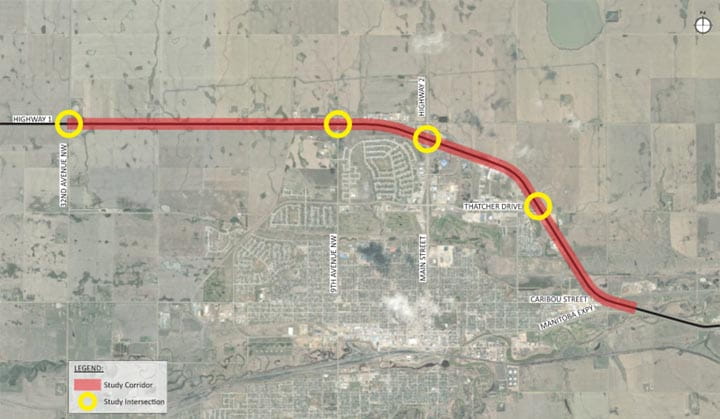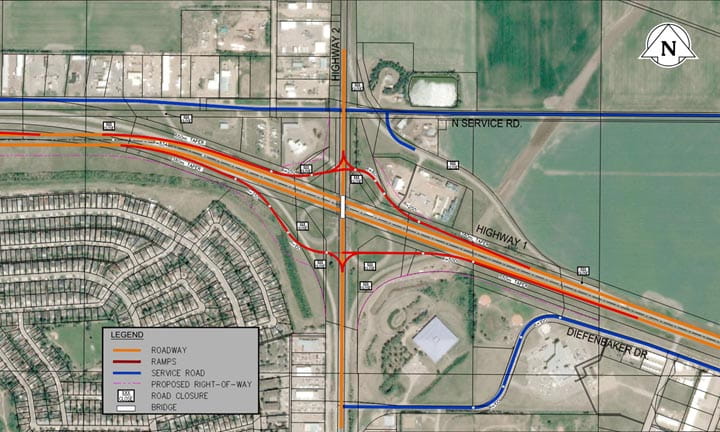Moose Jaw Corridor Study – Highway 1 Planning
1. Study Background
Highway 1 through Moose Jaw is an important part of the national highway system. Increasing traffic is straining the capacity of several key intersections. Changes are needed to improve safety and capacity. Any improvements must consider safety, limited space and maintaining access to local businesses and the community.
The study will focus on key intersections including 32nd Avenue NW, 9th Avenue NW, Highway 2, and Thatcher Drive.
Please review the material and complete the survey.
Study Area

In January / February 2023, potential solutions were presented at each study intersection. A survey was used to collect feedback. The following options were presented at each location:
- Highway 1 & 32nd Avenue NW: Partial Cloverleaf Interchange
- Highway 1 & 9th Avenue NW: Right-in / Right-out, Traffic Signals, Roundabout, Partial Cloverleaf Interchange
- Highway 1 & Highway 2: Diamond Interchange
- Highway 1 & Thatcher Drive: Traffic Signals, Roundabout, Diamond Interchange
The public indicated safety was the most important consideration. This was followed by mobility and ;traffic operations. The public’s feedback was incorporated into the evaluation which included several other criteria such as cost, development, business, and residential impacts, safety, traffic operations, and construction considerations.
2. Recommended Options
Highway 1 & 32 Avenue NW
This is a long-term solution and will be built when traffic volumes increase to result in significant delays and/or safety concerns. The actual design and location of service roads will be confirmed closer to construction with additional input from impacted landowners and stakeholders. An example design for a future partial cloverleaf interchange is shown in the following image.
Based on the evaluation, Option 4 – Partial Cloverleaf Interchange is recommended for the Highway 1 and 9th Avenue NW intersection.
Some key elements that set this option apart from the others include:
- Safety | Reduces the number of conflict points on Highway 1 by eliminating cross traffic.
- Traffic Operations | Accommodates traffic growth and does not impact Highway 1 operations.
- Opportunity to Accommodate Future Development | Improves access to 9th Avenue NW which may facilitate future development.
- Mobility of Freight | Accommodates truck traffic and over-dimensional vehicles.
- Design Expectation | Interchanges are the preferred intersection on freeways such as Highway 1.
- Network Connectivity | Maintains access to 9th Avenue NW in all directions.

Highway 1 & 9th Avenue NW
Based on the evaluation, Option 4 – Partial Cloverleaf Interchange is recommended for the Highway 1 and 9th Avenue NW intersection.
Some key elements that set this option apart from the others include:
- Safety | Reduces the number of conflict points on Highway 1 by eliminating cross traffic.
- Traffic Operations | Accommodates traffic growth and does not impact Highway 1 operations.
- Opportunity to Accommodate Future Development | Improves access to 9th Avenue NW which may facilitate future development.
- Mobility of Freight | Accommodates truck traffic and over-dimensional vehicles.
- Design Expectation | Interchanges are the preferred intersection on freeways such as Highway 1.
- Network Connectivity | Maintains access to 9th Avenue NW in all directions.
- The recommended design for a partial cloverleaf interchange is shown in the following image.

Highway 1 and Highway 2
The Ministry is hiring a consultant to complete the detailed design and construction administration. The actual interchange design and location of service roads will be confirmed through the project. An example of a diamond interchange is shown in the following image.

Highway 1 and Thatcher Drive
Based on the evaluation, Option 3 – Diamond Interchange is recommended for the Highway 1 and Thatcher Drive intersection.
Some key elements that set this option apart from the others include:
- Safety | Reduces the number of conflict points on Highway 1 by eliminating cross traffic.
- Traffic Operations | Accommodates traffic growth and does not impact Highway 1 operations.
- Opportunity to Accommodate Future Development | Improves access to Thatcher Drive which may facilitate future development.
- Mobility of Freight | Accommodates truck traffic and over-dimensional vehicles.
- Design Expectation | Interchanges are the preferred intersection on freeways such as Highway 1.
- Network Connectivity | Maintains access to Thatcher Drive in all directions.
An interchange at Thatcher Drive is a long-term solution and will be built when traffic volumes increase to result in significant delays and/or safety concerns. The actual design and location of service roads will be confirmed closer to construction with additional input from impacted landowners and stakeholders. An example of a future diamond interchange is shown here.

Highway 1 - Moose Jaw Corridor Flyover
3. Complete the Survey
The survey is now closed. Thank you for your feedback!
Next Steps
- Evaluate survey feedback
- Refine design of recommended options based on feedback
- Prepare Final Report
4. Contact
Josh Kerr, P. Eng.
Senior Project Manager, Design Delivery
Government of Saskatchewan
Email: joshua.kerr@gov.sk.ca
Phone: 306-519-8277
